Top speed 227 km/h Wingspan 13 m Engine type Turboshaft | Length 16 m Manufacturer Bell Helicopter Number of seats 2 | |
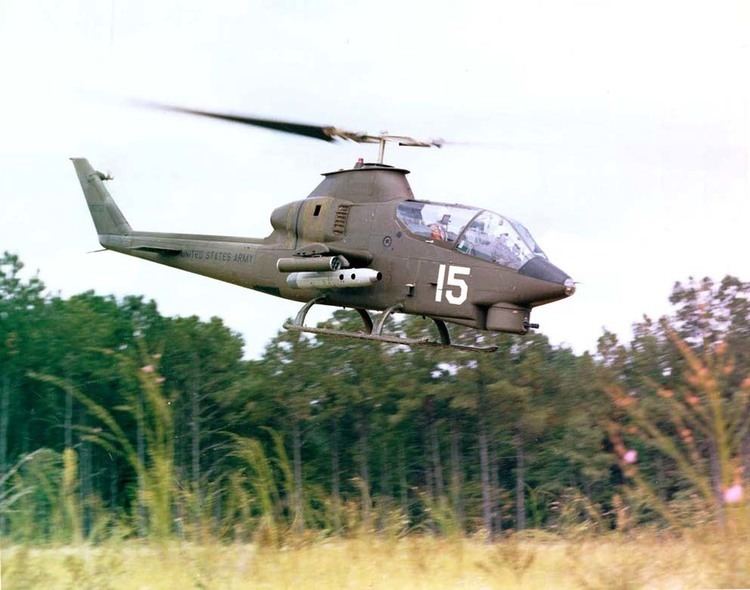 | ||
Unit cost 11,300,000–11,300,000 USD (1995) | ||
The Bell AH-1 Cobra is a two-blade, single-engine attack helicopter manufactured by Bell Helicopter. It was developed using the engine, transmission and rotor system of the Bell UH-1 Iroquois. A member of the prolific Huey family, the AH-1 is also referred to as the HueyCobra or Snake.
Contents
- Background
- Iroquois Warrior Sioux Scout and AAFSS
- Model 209
- Into production
- US military
- Israel
- Japan
- Jordan
- Turkey
- Pakistan
- US firefighting
- Single engine
- Operators
- AH 1G HueyCobra
- AH 1F Modernized Cobra
- References
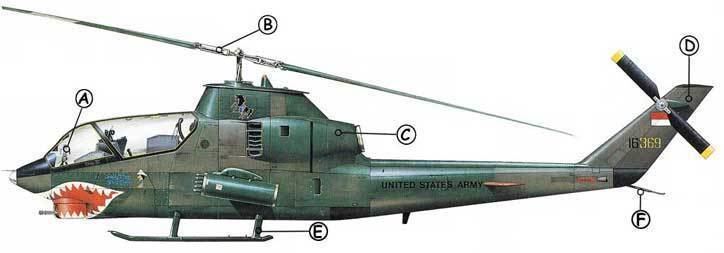
The AH-1 was the backbone of the United States Army's attack helicopter fleet, but has been replaced by the AH-64 Apache in Army service. Upgraded versions continue to fly with the militaries of several other nations. The AH-1 twin engine versions remain in service with United States Marine Corps (USMC) as the service's primary attack helicopter. Surplus AH-1 helicopters have been converted for fighting forest fires.
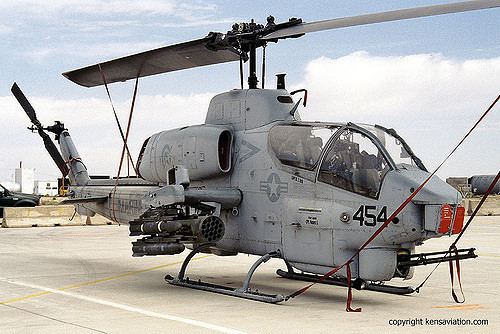
Background
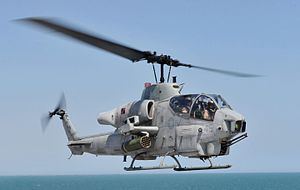
Closely related to the development of the Bell AH-1 is the story of the Bell UH-1 Iroquois—icon of the Vietnam War and one of the most numerous helicopter types built. The UH-1 made the theory of air cavalry practical, as the new tactics called for US forces to be highly mobile across a wide area. Unlike before, they would not stand and fight long battles, and they would not stay and hold positions. Instead, the plan was that the troops carried by fleets of UH-1 "Hueys" would range across the country, to fight the enemy at times and places of their own choice.
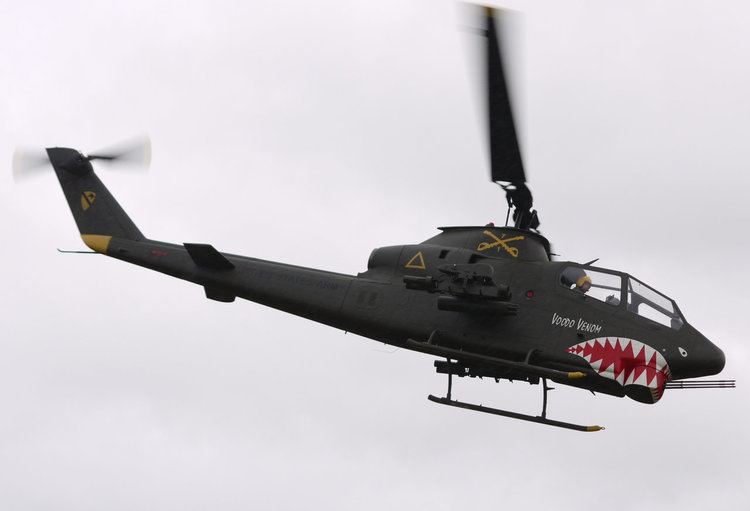
It soon became clear that the unarmed troop helicopters were vulnerable against ground fire from Việt Cộng and North Vietnamese troops, particularly as they came down to drop their troops in a landing zone. Without friendly support from artillery or ground forces, the only way to pacify a landing zone was from the air, preferably with an aircraft that could closely escort the transport helicopters, and loiter over the landing zone as the battle progressed. By 1962 a small number of armed UH-1As were used as escorts, armed with multiple machine guns and rocket mounts.
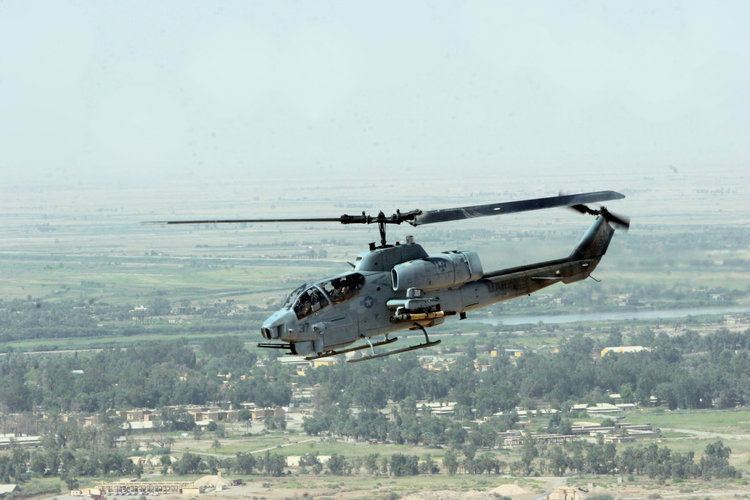
The massive expansion of American military presence in Vietnam opened a new era of war from the air. The linchpin of US Army tactics was the helicopters, and the protection of those helicopters became a vital role.
Iroquois Warrior, Sioux Scout and AAFSS

Bell had been investigating helicopter gunships since the late 1950s, and had created a mockup of its D-255 helicopter gunship concept, named "Iroquois Warrior". In June 1962, Bell displayed the mockup to Army officials, hoping to solicit funding for further development. The Iroquois Warrior was planned to be a purpose-built attack aircraft based on UH-1B components with a new, slender airframe and a two-seat, tandem cockpit. It featured a grenade launcher in a ball turret on the nose, a 20 mm belly-mounted gun pod, and stub wings for mounting rockets or SS.10 anti-tank missiles.
The Army was interested and awarded Bell a proof-of-concept contract in December 1962. Bell modified a Model 47 into the Model 207 Sioux Scout which first flew in July 1963. The Sioux Scout had all the key features of a modern attack helicopter: a tandem cockpit, stub wings for weapons, and a chin-mounted gun turret. After evaluating the Sioux Scout in early 1964, the Army was impressed, but also felt the Sioux Scout was undersized, underpowered, and generally not suited for practical use.
The army's solution to the shortcomings of the Sioux Scout was to launch the Advanced Aerial Fire Support System (AAFSS) competition. The AAFSS requirement gave birth to the Lockheed AH-56 Cheyenne, a heavy attack helicopter with high speed capability. It proved to be too sophisticated, and was canceled in 1972, after ten years of development. The Army sought greater survivability in a conventional attack helicopter.
Model 209
At the same time, despite the Army's preference for the AAFSS–for which Bell Helicopter was not selected to compete–Bell stuck with their own idea of a smaller and lighter gunship. In January 1965 Bell invested $1 million to proceed with a new design. Mating the proven transmission, the "540" rotor system of the UH-1C augmented by a Stability Control Augmentation System (SCAS), and the T53 turboshaft engine of the UH-1 with the design philosophy of the Sioux Scout, Bell produced the Model 209. Bell's Model 209 largely resembled the "Iroquois Warrior" mockup.
In Vietnam, events were also advancing in favor of the Model 209. Attacks on US forces were increasing, and by the end of June 1965 there were already 50,000 US ground troops in Vietnam. 1965 was also the deadline for AAFSS selection, but the program would become stuck in technical difficulties and political bickering. The U.S. Army needed an interim gunship for Vietnam and it asked five companies to provide a quick solution. Submissions came in for armed variants of the Boeing-Vertol ACH-47A, Kaman HH-2C Tomahawk, Piasecki 16H Pathfinder, Sikorsky S-61, and the Bell 209.
On 3 September 1965 Bell rolled out its Model 209 prototype, and four days later it made its maiden flight, only eight months after the go-ahead. In April 1966, the model won an evaluation against the other rival helicopters. The Army then signed the first production contract for 110 aircraft. Bell added "Cobra" to the UH-1's Huey nickname to produce its HueyCobra name for the 209. The Army applied the Cobra name to its AH-1G designation for the helicopter.
The Bell 209 demonstrator was used for the next six years to test weapons and fit of equipment. It had been modified to match the AH-1 production standard by the early 1970s. The demonstrator was retired to the Patton Museum at Fort Knox, Kentucky and converted to approximately its original appearance.
Into production
The Bell 209 design was modified for production. The retractable skids were replaced by simpler fixed skids. A new wide-blade rotor was featured. For production, a plexiglass canopy replaced the 209's armored glass canopy which was heavy enough to harm performance. Other changes were incorporated after entering service. The main one of these was moving the tail rotor from the helicopter's left side to the right for improved effectiveness of the rotor.
The U.S. Marine Corps was interested in the Cobra and ordered an improved twin-engined version in 1968 under the designation AH-1J. This would lead to more twin-engine variants. In 1972, the Army sought improved anti-armor capability. Under the Improved Cobra Armament Program (ICAP), trials of eight AH-1s fitted with TOW missiles were conducted in October 1973. After passing qualification tests the following year, Bell was contracted with upgrading 101 AH-1Gs to the TOW-capable AH-1Q configuration. Following AH-1Q operational tests, a more powerful T53 engine and transmission were added from 1976 resulting in the AH-1S version. The AH-1S was upgraded in three steps, culminating with the AH-1F.
U.S. military
By June 1967, the first AH-1G HueyCobras had been delivered. Originally designated as UH-1H, the "A" for attack designation was soon adopted and when the improved UH-1D became the UH-1H, the HueyCobra became the AH-1G. The AH-1 was initially considered a variant of the H-1 line, resulting in the G series letter.
AH-1 Cobras were in use by the Army during the Tet offensive in 1968 and through to the end of the Vietnam War. Cobras provided fire support for ground forces, escorted transport helicopters and other roles, including aerial rocket artillery (ARA) battalions in the two Airmobile divisions. They also formed "hunter killer" teams by pairing with OH-6A scout helicopters. A team featured one OH-6 flying slow and low to find enemy forces. If the OH-6 drew fire, the Cobra could strike at the then revealed enemy. On 12 September 1968, Capt. Ronald Fogleman was flying an F-100 Super Sabre when the aircraft was shot down and he ejected 200 miles north of Bien Hoa. Fogleman became the only pilot to be rescued by holding on to an Army AH-1G's deployed gun-panel door. Bell built 1,116 AH-1Gs for the U.S. Army between 1967 and 1973, and the Cobras chalked up over a million operational hours in Vietnam; the number of Cobras in service peaked at 1,081. Out of nearly 1,110 AH-1s delivered from 1967 to 1973 approximately 300 were lost to combat and accidents during the war. The U.S. Marine Corps used AH-1G Cobras in Vietnam for a short time before acquiring twin-engine AH-1J Cobras.
AH-1T Cobras were deployed for Operation Urgent Fury, the invasion of Grenada in 1983, flying close-support and helicopter escort missions, two of the four available lost to anti-aircraft fire while attacking Fort Frederick. Army Cobras participated in Operation Just Cause, the U.S. invasion of Panama in 1989.
During Operations Desert Shield and Desert Storm in the Gulf War (1990–91), the Cobras and SuperCobras deployed in a support role. The USMC deployed 91 AH-1W SuperCobras and the US Army 140 AH-1 Cobras; these were operated from forward, dispersed desert bases. Three AH-1s were lost in accidents during fighting and afterward. Cobras destroyed many Iraqi armored vehicles and various targets in the fighting.
Army Cobras provided support for the US humanitarian intervention during Operation Restore Hope in Somalia in 1993. They were also employed during the US invasion of Haiti in 1994. US Cobras were also used in operations later in the 1990s.
The U.S. Army phased out the AH-1 during the 1990s and retired the AH-1 from active service in March 1999, offering them to NATO allies. The Army retired the AH-1 from reserves in September 2001. The retired AH-1s have been passed to other nations and to the USDA Forest Service. The AH-1 continues to be in service with the US military, by the US Marine Corps, which operate the twin-engine AH-1W SuperCobra and AH-1Z Viper.
Israel
The Israeli Air Force named its Cobras as the "Tzefa" (Hebrew: צפע, for Viper). Since the mid-1970s Lebanon has been Israel's most active front; IAF Cobras had been fighting there for more than 20 years.
Cobra helicopters were also used widely by the Israeli Air Force in the 1982 Lebanon War to destroy Syrian armor and fortification. IAF Cobras destroyed dozens of Syrian ground vehicles. The Cobras were also used in major operations against Hezbollah in Operations "Accountability" and "Grapes of Wrath" in southern Lebanon.
Israel retired its fleet of some 33 AH-1 Cobras in late 2013 due to budget cuts. The attack helicopter role was taken up entirely by the squadrons of Israeli AH-64 Apache helicopters, and the fleet of unmanned aerial vehicles took over the role of patrolling combat zones. The Cobra fleet was older than the Apaches and responsible for some fatal crashes, and more expensive to maintain than UAVs and more vulnerable for pilots to MANPADS fired by guerrilla groups. In late 2014, Israel transferred some 16 Cobras to the Jordanian Air Force, adding to their existing fleet, for border security in response to threats posed by Islamic State militants or other insurgent groups.
Japan
Japan manufactured 89 AH-1S Cobras which were licensed by Fuji Heavy Industries from 1984 to 2000. The type is used by the Japan Ground Self-Defense Force, and are Step 3 models, which are roughly the equivalent to the United States Army's AH-1Fs. The engine is the T53-K-703 turboshaft, which Kawasaki Heavy Industries produced under license.
Jordan
Jordan obtained 24 AH-1Fs in the late 1980s, and in 2001 obtained nine additional ex-US Army Cobras. In 2010 Jordan transferred 16 AH-1F helicopters to Pakistan, under a US-sponsored support program that provided Islamabad with 40 AH-1 refurbished helicopters.
The Royal Jordanian Air Force has at least one squadron of Cobras currently in service, and is supposed to have used them in combat in Iraq and Syria.
Turkey
Turkey bought ten AH-1Ws in the early 1990s, and supplemented them with 32 ex-US Army Cobras. The US Army Cobras included some TAH-1P trainers and the rest were brought up to AH-1F version. Turkish Cobras have seen actual combat in operations against Kurdish insurgents near the Iraqi border. Some Cobras have been lost in these operations.
Pakistan
Pakistan was supplied with 20 AH-1S gunships by the U.S. from 1984 to 1986, these were later upgraded with the C-NITE thermal imaging package. AH-1s were used as Pakistan's main gunship helicopters against insurgents during the Balochistan conflict. The ongoing War in North-West Pakistan has seen Pakistani AH-1s in action against Taliban and Al Qaeda fighters as well as their tribal allies. The U.S. delivered 12 AH-1Fs to Pakistan in 2007, with 14 more AH-1F Cobras supplied in 2010.
Pakistan had 35 AH-1F helicopters in use in 2013. Maintaining these aircraft has been difficult, but possible through commercial channels. Additionally, the U.S. Government has given $750,000 to update a portion of Pakistan Army Aviation's existing AH-1F/S Cobra fleet. Turkey has also supplied spare parts of Cobra helicopters to Pakistan free of cost. Pakistan has repeatedly sought Bell AH-1 SuperCobra attack helicopters from the U.S. to supplement and replace its current AH-1 Cobras. Pakistan has lost three aircraft in recent years. Attempts to acquire the AH-1Z Viper or AH-64 Apache from the U.S. have been rejected, so Pakistan turned to buying other foreign attack helicopters to replace its aging AH-1F fleet. Possible candidates included the Turkish TAI T-129, the Chinese CAIC Z-10, and the Russian Mi-35 Hind. In November 2014, Russia approved the sale of Mi-35M helicopters to Pakistan. In April 2015, China delivered three Z-10s to Pakistan. During the same month, the US State Department approved the sale of 15 AH-1Zs and associated equipment to Pakistan.
U.S. firefighting
In 2003, the U.S. Forest Service acquired 25 retired AH-1Fs from the U.S. Army. These have been designated Bell 209 and are being converted into Firewatch Cobras with infrared and low light sensors and systems for real time fire monitoring.
The Florida Division of Forestry also acquired three AH-1Ps from the U.S. Army. These are called Bell 209 "Firesnakes" and are equipped to carry a water/fire retardant system.
Single-engine
Operators
A small number of former military helicopters are operated by civil organizations for display and demonstration, for example by Red Bull.
AH-1G HueyCobra
Data from Modern Military Aircraft, Verier, Modern Fighting Aircraft
General characteristics
Performance
Armament
AH-1F "Modernized" Cobra
Data from Verier, Modern Fighting Aircraft
General characteristics
Performance
Armament
